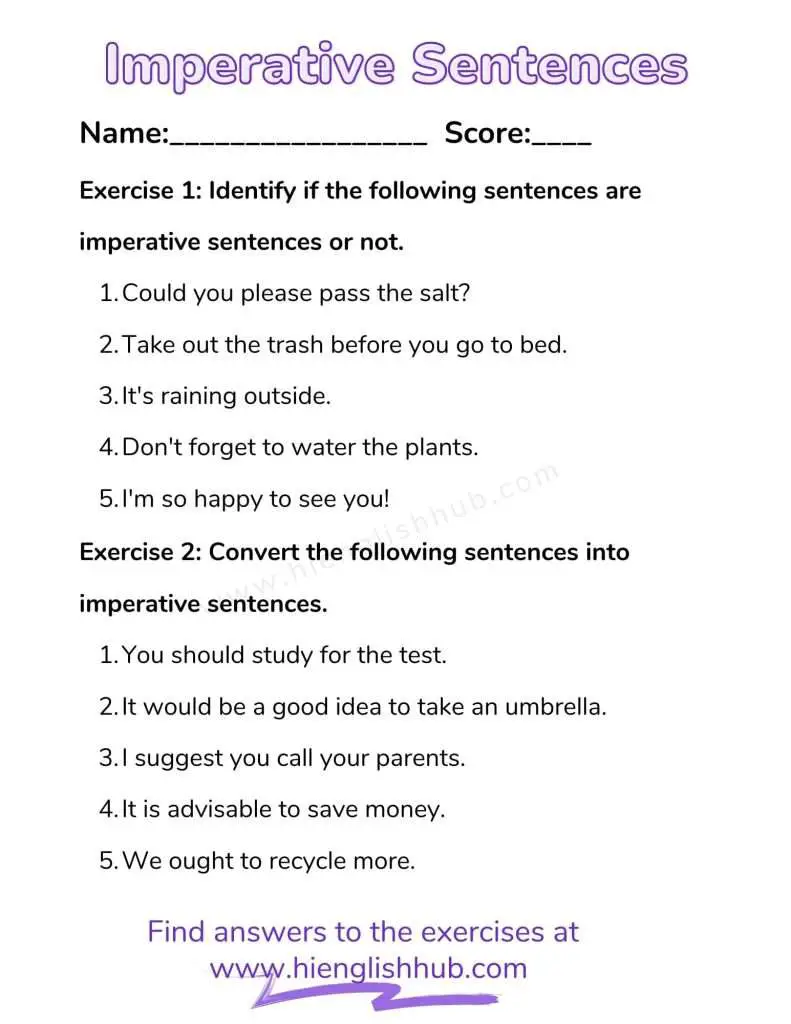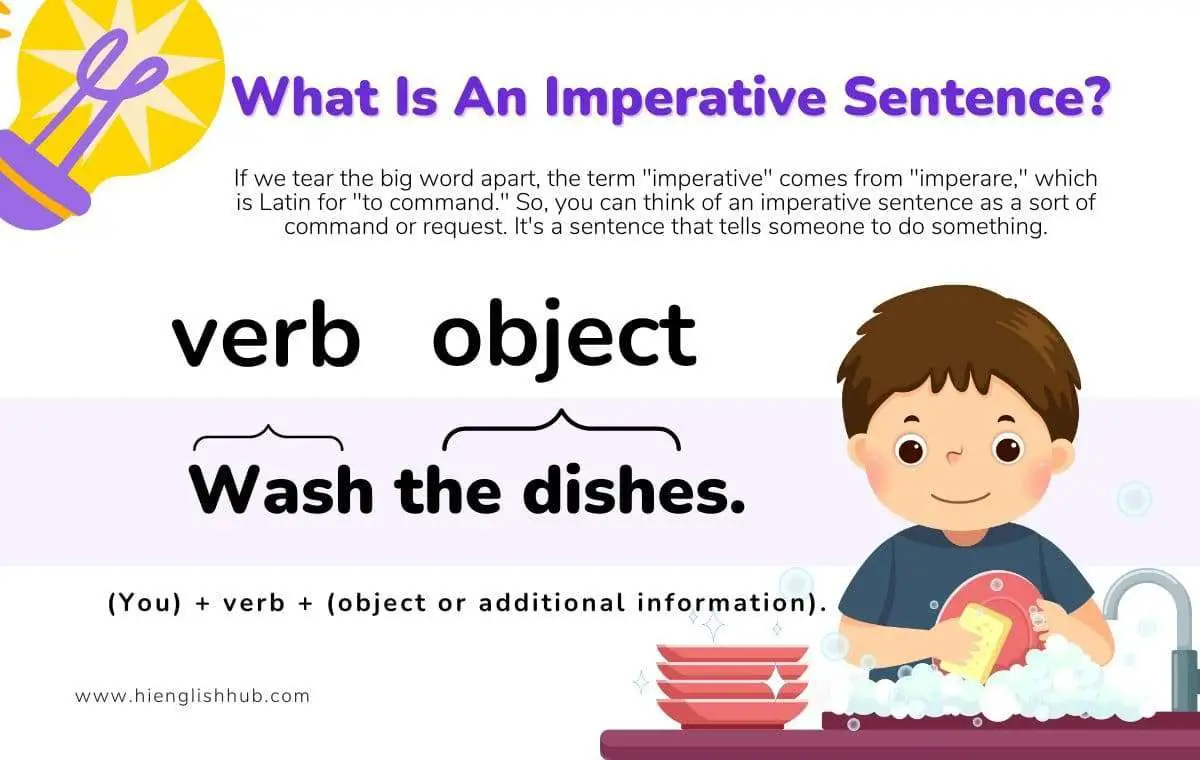Hello, language enthusiasts!
Ever wondered about the secret sauce that adds zest to our everyday conversations, spruces up your commands, or gives that polite tone to your requests?
Well, today we’re exploring that essential ingredient of English language—the mighty “imperative sentence.”
These are the powerhouses that get things done. They’re the magic wands in our language toolbox, helping us command, request, advise, or caution.
Exciting, right?
So, buckle up and get ready to dive deep into the world of imperative sentences. By the end of this, you’ll be casting spells of persuasion and instruction like a pro!
So, let’s jump right in!
What Is An Imperative Sentence?
Now, what is an imperative sentence? If we tear the big word apart, the term “imperative” comes from “imperare,” which is Latin for “to command.” So, you can think of an imperative sentence as a sort of command or request. It’s a sentence that tells someone to do something.
Imagine you’re a wizard with a wand, and every time you wave it and command—”lights on,” “clean room,” “homework done,”—it happens! Cool, right? Well, that’s the magic of an imperative sentence.
Basic Structure Of Imperative Sentences
Next, let’s talk about the structure of these sentences.
Imperative sentences usually start with a verb, which is the action word.
The subject of the sentence, which is usually the person you’re speaking to, is understood to be “you.”
But guess what? It’s an invisible “you!” Because in imperative sentences, we usually don’t mention it.
So the structure of an imperative sentence looks something like this:
(You) + verb + (object or additional information).
For example:
- Wash the dishes. The verb is “wash,” and “the dishes” is the object that the action is being done to.
- Run to the store and buy some milk. In this sentence, “run” and “buy” are the verbs. “The store” and “some milk” are the objects.
The basic structure can be extended by adding more information, such as the reason for the action or details about how, when, where, or why the action should happen.
Further reading: What Is An Interrogative Sentence?
Examples Of Imperative Sentences
Here are some examples to help you understand better:
- Stop.
- Clean your room.
- Close the door.
- Don’t procrastinate on your homework.
- Practice your piano lessons daily.
- Make sure to save some money from your allowance.
- Identify the part of speech for each word in this sentence.
- Help your mom with the dishes.
- Please finish your homework.
- Get some exercise every day to stay healthy.
- Use reported speech to tell me what she said.
- Don’t forget to water the plants.
- Bake the cookies for 15 minutes.
- Always recycle paper and plastic.
Imperative Sentence Worksheet With Answers

Exercise 1: Identify if the following sentences are imperative sentences or not.
- Could you please pass the salt?
- Take out the trash before you go to bed.
- It’s raining outside.
- Don’t forget to water the plants.
- I’m so happy to see you!
Answers:
- No, this sentence is not an imperative sentence. It’s a question. However, it’s used to make a polite request, so it serves a similar function to an imperative sentence in practice.
- Yes, this is an imperative sentence. It’s giving a command.
- No, this sentence is not an imperative sentence. It’s a declarative sentence, stating a fact.
- Yes, this is an imperative sentence. It’s giving a command.
- No, this sentence is not an imperative sentence. It’s an exclamatory sentence, expressing emotion.
Exercise 2: Convert the following sentences into imperative sentences.
- You should study for the test.
- It would be a good idea to take an umbrella.
- I suggest you call your parents.
- It is advisable to save money.
- We ought to recycle more.
Answers:
- Study for the test.
- Take an umbrella.
- Call your parents.
- Save money.
- Recycle more.
Remember, in the process of conversion, we usually drop the subjects and modals (like should, would, etc.), as an imperative sentence typically starts with a verb and is addressed to an understood “you”.
FAQs On Imperative Sentences
Now let’s get into some FAQs to broaden our understanding.
What Are 10 Examples Of Imperative Sentences?
1. Sign up for the Amazon Prime 30-day free trial.
2. Enjoy the party.
3. Try saying these tongue twisters fast.
4. Visit your grandmother.
5. Study for the IELTS speaking test.
6. Don’t touch the hot stove.
7. Let’s count numbers 1 to 100 together.
8. Remember to lock the door.
9. Come on, play Truth or Dare with us.
10. Listen to audiobooks on Amazon Audio for free.
What Is An Example Of An Imperative Sentence In The Classroom?
Here are some classic classroom spells:
– Open your books to page 52.
– Please put your pencils down.
– Don’t run in the hallway.
– Raise your hand if you know the answer.
– Always double-check your work before submitting it.
– Turn off the lights when you leave the room.
What Is An Imperative Sentence Example For Kids?
Check these out:
– Put on your shoes.
– Eat your vegetables.
– Don’t tease your sister.
– Always say please and thank you.
Can An Imperative Sentence Be One Word?
Yes, indeed! Here are some one-word spells:
– Run!
– Jump!
– Stop!
– Listen!
As you can see, even a single word can be a complete imperative sentence. It’s because the invisible “you” and the verb are all you need for the magic to work!
Wrapping Up
Well, that’s it for our exciting exploration of imperative sentences!
This structure is a secret recipe for all the command, advice, or request sentences you will ever need. Cool, isn’t it?
The next time you read a book or talk with your friends, see if you can spot these sentences. It’ll be a fun little magic hunt!
And remember, the power of language is your wand, so use it wisely!


